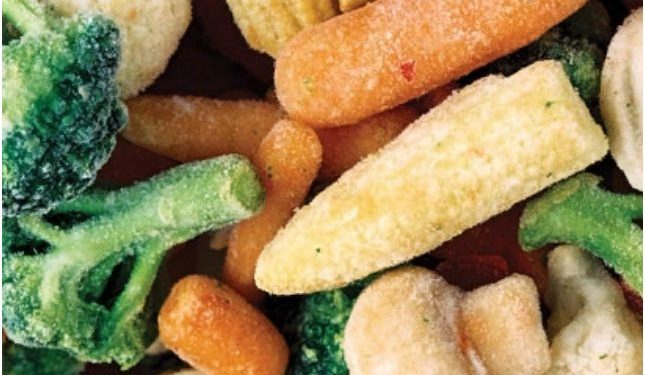Fields and orchards can be wonderful, magical worlds unto themselves
You just don’t want their residents – or invaders – to end up in your salad or bag of frozen strawberries. Nor do consumers find wilted, dried leaves or mushy brown berries appetizing.
That’s where sorting and x-ray/metal detection come in. Whether destined for a fresh-cut processor, freezing or canning, the produce comes from the same place: outdoors. Frogs, snakes, bugs, foreign objects like metal, imperfections in the product itself – all must be identified and removed in the most efficient way during processing.
And the potential for invaders doesn’t end once the produce reaches the plant. Despite the protective wear and various safeguards most have in place, objects can get into the mix there, too.
“In the industry, companies tend to differentiate between sorting technology and x-ray/metal detection,” said Richard F. Stier, a consulting food scientist in Sonoma, California. “The latter technologies are designed to remove specific foreign materials.”
Metal detectors and x-ray machines can identify metal, stones, hard bones, plastics and other materials based on density differentials, Stier said. He stresses that they’re a different animal than the sorting technologies, which employ lasers and different light sources.
Sorting: How and When
John Kadinger, Key Technology market manager based in Walla Walla, Washington, said that besides optical sorting using color cameras with standard and infrared options that can pick up differences in colors and textures to differentiate between good product and everything else, laser systems are effective when screening product upon coming into a plant – on their own or in combination with cameras, depending on the application. The fluorescence-sensing laser sorter identifies different levels of chlorophyll along with color, size and shape to tell the good from the not.
Kadinger said metal detection is typically the last check for metallic foreign material in actual packages.
“Digital sorting, on the other hand, can be performed at multiple places in the line,” he said. “The main difference is digital sorting uses multiple sensor types to identify foreign material and defects using multiple characteristics … color, shape, size, structure and biochemical properties.”
Using metal detection once packaging is completed without earlier screening can be wasteful, he said. Should foreign material be found, the whole package gets removed, Kadinger said. Companies that screen product earlier can be more efficient and see less waste, he said.
“We’re doing bulk sorting at the receiving end or sorting just before packaging or anywhere in between, depending on the plant layout,” he said. “We’re looking primarily for foreign material and defects when it comes into the plant. Later in the process, it is more focused on defects, but foreign material is also still important. Where the sorter is placed depends on the philosophy of the plant.”
Some operations use more sorters earlier in the process to ensure that the bulk of the unwanted foreign materials and defective items are removed sooner rather than later – the routine that Kadinger endorses.
“It used to be, do all the processing up front, then sort and do that quality check before packaging,” Kadinger said. “But now some are finding it improves the process by sorting up front.”
That can be more efficient in that “they’re not processing stuff they’re not going to sell,” Kadinger said. “It’s easier to remove defects sooner, only processing mainly good product.”
He adds that some of the “good product” that gets swept aside with the bad in early screening can be put through a second sort and recovered.
“We believe it’s optimum to sort to improve your yield and efficiency as soon as you can,” he said, “and also to make sure at the end that nothing has been introduced to the stream like earplugs, gloves or something used in the plant. Our position is (sort at) both ends.”
Of course, the commodity has a lot to do with the process, too.
“Generally for a fresh-cut application we recommend camera and laser sensors for both the early sort or later in the process,” Kadinger said, citing spinach with its tendency to come in with a lot of field debris as an example of a suitable use for the combined technology.
In nuts and dried fruits, Kadinger said Key has been experimenting with cameras that use a “hyper-spectral color spectrum” to help differentiate between subtle differences in colorations. For example, the shells, hulls and membranes inside walnuts and almonds are very similar in color, making it hard to distinguish what’s what.
“Hyper-spectral gives a better contrast,” he said.
Process Matters
The type of processing also makes a difference.
TOMRA recently introduced a sorter that uses pulsed light-emitting diodes with multiple infrared wavelengths and color cameras for inspecting individually quick frozen vegetables and fruits. Designed to handle output of individually quick frozen tunnels, it can be installed after the tunnels or prior to packing.
Camilo Sanchez, x-ray product manager for Mettler Toledo Spaceline, said his company offers several variations on x-ray equipment designed for various applications. Bulk fresh-cut produce gets one type of application versus frozen versus canned, though all of the company’s x-ray processes are designed to detect contaminants of all sizes, shapes and location while performing integrity checks.
With the Mettler Toledo x-ray systems, fresh-cut would get inspected immediately after cutting, prior to packaging. That should be followed by an end-of-line inspection as well, he said.
Sanchez recommends a similar process for frozen – before it goes into the tunnel to be frozen or into filler devices, and again after packaging.
“Usually, most of our customers are interested in doing end-of-line inspection, in addition to the first inspection point,” Sanchez said. “It reduces waste and actually protects other processing equipment the customer may have.
“Let’s say in produce from the field, there’s a large piece of metal … it can get into the cutting machine and break the blade. That’s down time, and damage to the cutting equipment.”
Inspection and sorting also should take place in the canning process early on, “to ensure you’re not introducing any large contaminants,” Sanchez said. At the conclusion, cans are run through x-ray inspection technology for a final view– as many as 1,800 per minute, he said.
“X-ray is the only technology in the marketplace that is capable of inspection in the can, and detecting,” he said.
Sanchez said that as x-ray technology has become more affordable and friendly to being customized in the last three to five years, its use has been growing. Novus X-ray of Blue Bell, Pennsylvania, describes new x-ray devices as being easier to operate and repair. In-house equipment operators need not be specialists, the company said, since newer devices come with automatic training algorithms that enable them to be set up quickly and easily. They’re also easier to repair, according to company literature.







